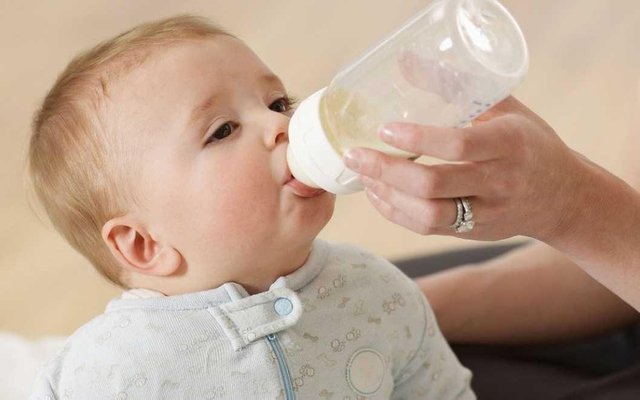
According to new studies, infants fed from the mixture were born based on soybeans, there are differences in some tissues of the reproductive system than those who were breastfed or using a mixture of cow's milk. The discrepancies were found within a few months after a smooth and harmless birth, but further research on the effect of substances in the nutrient mixture based on soybeans.
often scientific articles that I read, cause only theoretical interests (and sometimes even boredom is terrible and no interest), but research scientists sometimes lead to providing food for the revaluation of our daily habits. For example, there is a study in carcinogenicity in human mammals. Or here today - about what baby food is safer, expectant mothers and their friends it should be interesting.
Baby food based on soy-based formula (soy-based formula) is made by the food industry to replace mother's milk. It is a commercial product based on soy protein that is ground into a powder and then pours water into liquids to feed newborns. However, the mixture contains high concentrations such as plant estrogen (estrogen is a female hormone).Often, the mixture is the only source of food for children during the first few months of life, and it is important to understand the effects of these compounds on the body at a critical time of its development. This is explained by Dr. Virginia Stallings (Virginia Stallings), director of the nutrition center at Children's Hospital of Philadelphia. He became the lead author of the study, whose results are published in the scientific journal "Journal of Clinical Endocrinology and Metabolism".The work was commissioned by the National Institutes of Health and Environmental Sciences.
Modern soy-based baby formula has been used for decades and is considered a substitute for a completely safe traditional product. However, observational studies have detected changes in estrogen sensitive tissues in children, and it is unknown whether these changes are associated with long-term health effects.Often mothers who are not breastfeeding are forced to use a diet based on soy formulas as an alternative to cow's milk, because the child is allergic to him, lactose intolerance or other nutritional problems. However, soy protein contains large amounts of genistein, estrogen-like compounds. Like other mimic estrogen chemicals found in natural products, genistein can alter the body's endocrine system and potentially interfere with normal hormonal development.In laboratory studies, genistein causes abnormal reproductive development and subsequent function in adult rodents, but little is known about its effect on the human body - no one conducts such a dangerous experiment.

In the study of American scientists, postnatal development (after birth) of estrogen sensitive organism tissue was studied, and these values were compared with the same parameters in breast-fed infants or nutrients with cow milk mixtures.Overall, 283 couples (mother-infants) were selected for observation. Of these, mixed with soy formula, 111 - mixed with cow's milk and 70- for breastfeeding. All mothers first decide to feed their baby, and only then are they taken to a surveillance program. The ratio of boys and girls in this study is approximately equal, 70 percent of the children are African Americans. All that was observed was born in eight hospitals in Philadelphia.
Children were observed until the age of 28 weeks in boys and 36 weeks in girls. The research team evaluated three sets of parameters: maturation index (MI) based on urogenital tissue epithelial cells; Ultrasound measurements of the volume of the uterus, ovaries and testes; as well as the concentration of hormones in the blood, based on the analysis.The main differences found with different diets are observed in girls. Those who received food based on soy formulas had developments that matched with high estrogen levels, MI higher than peers. There is a difference in the size of the reproductive organs, which is also a characteristic of estrogen-like reactions. In dairy cattle milk, no changes were observed compared to breastfeeding.Stallings says that it is unknown whether these changes will have negative consequences, this is a topic for the future of a major study. Ideally, these three groups of children should be observed in the years to come and identify patterns of health in adolescence and further in adulthood.For young mothers and expectant mothers who decide to feed their babies, the American Academy of Pediatrics strongly recommends breastfeeding is completely safe. It was created for us by evolution and the human body adapted to it, and not to grate the soy. For formula feeding, a mixture of soy formula for premature infants is not recommended at this time, but for infant with inherited disorders that do not allow proper milk digestion (eg galactosemia), soy formula is still the only food option.In addition, soybean parents prefer to live a vegetarian lifestyle. Maybe, in this way they are risking the health of their children to a small degree. Future research should finally answer the question of the danger (or misfortune) of mixing with soy formula, But for now everyone decides for his own son.Future research should finally answer the question of the danger (or misfortune) of mixing with soy formula, But for now everyone decides for his own son. In my opinion, it's better not to risk it!

Menjaga kestabilan anak
Downvoting a post can decrease pending rewards and make it less visible. Common reasons:
Submit
Sepi malam ini
Downvoting a post can decrease pending rewards and make it less visible. Common reasons:
Submit